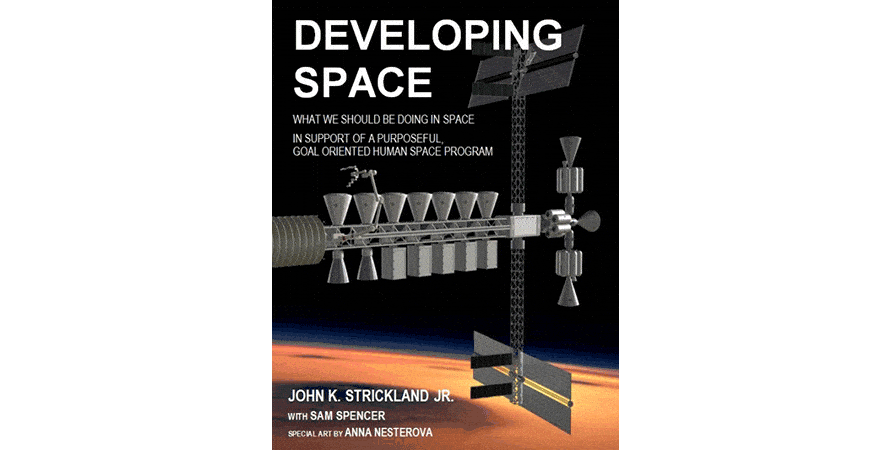Category: Non-Fiction
Reviewed by: Casey Suire
From Ad Astra Summer 2021
Title: Developing Space
Author: John K. Strickland Jr.
NSS Amazon link for this book
Format: Paperback
Pages: 354
Publisher: Apogee Books
Date: January 2021
Retail price: $45.00
ISBN: 978-1989044148
“I regarded the text so highly that advance copies have already been used to shape the minds of future Air Force officers who will one day be charged with providing security for the project of human expansion into space.”
This is what Lt Col Peter Garretson, USAF (Ret), had to say about the book. When readers flip through the pages, they will quickly understand his point. John Strickland, the principal author, and co-author Sam Spencer have put a lot of thought and effort into Developing Space. Considering all the meticulous details packed into the book’s pages, the $45 retail price is a bargain.
If Strickland and Spencer’s text isn’t enough, Anna Nesterova’s stunningly beautiful artwork really brings the book’s ideas to life. There are also a lot of calculations in Developing Space. Readers that excel at math will appreciate topics such as delta-V, Oberth maneuvers, C3, and vis-viva equations. Those who aren’t interested in math can simply skip the calculations. The math is helpful, but not necessary, in understanding the book’s concepts.
Readers will also find that Strickland, a longtime space advocate and National Space Society leader, has plenty to say about the future of space. So much so that Developing Space is actually the first in a two-book series. The second book, titled Settling Space, explores humanity’s spacefaring future even further than in the first book.
As for Developing Space, early chapters are short and focused on space policy and cheap access to space. Later chapters are much longer and involve cislunar space, lunar and Martian exploration, and space solar power. There is also a very large appendix that supplies the reader with even more detailed and useful information. One such example is the “Why Space?” section—a checklist of several reasons for human activity in space. The appendix also contains a list of possible human landing sites on Mars.
Early on, Strickland describes current American space policy as “dysfunctional.” He is not a fan of expendable rockets and “flags and footprints” missions. He prefers reusable rockets, space infrastructure, logistics bases, and propellant depots. Strickland, unlike many other space advocates, is not a goal or destination chauvinist. He believes in the human exploration and settlement of a variety of space destinations. This is in stark contrast to those who just want robotic and not human space exploration. Strickland refers to this as the “look but do not touch” policy.
Despite his support for space infrastructure, Strickland disagrees with NASA’s Lunar Gateway. Strickland refers to the gateway, a lunar space station that will support the Artemis program, as “the gateway without a gate.” The NASA gateway will not have features such as a propellant depot or a cargo handling and transfer capability. Another criticism is that the Lunar Gateway’s near-rectilinear halo orbit (NRHO) will mostly keep it far away from the lunar surface. This, he argues, will make it difficult for the Lunar Gateway to support a base on the lunar surface.
Strickland’s Access to Mars (AtM) concept, which was presented at the 2011 International Space Development Conference (ISDC), is covered in great detail. One interesting element of AtM is a fleet of reusable ferry spacecraft that would shuttle back and forth between the surface of Mars and a logistics base in low Martian orbit. Unlike other Mars mission designs, such as SpaceX’s Starship, the AtM ferries will not use liquid methane and liquid oxygen propellant from the Martian atmosphere. Instead, more powerful liquid hydrogen and liquid oxygen will be produced from Martian water ice. AtM is also noteworthy for proposing supersonic retro-propulsion (SRP) as a method of landing ferries on Mars. Supersonic retro-propulsion, where a supersonic spacecraft uses its engines to slow down during descent, was successfully demonstrated by SpaceX in 2015. SpaceX also plans to use SRP for landing Starships on Mars.
Whether you’re a novice looking to learn more about the field, an experienced space professional in need of a reference guide, or even one of Garretson’s Air Force officers, Developing Space will probably have something for you. It is a highly detailed account of what humans should be doing in space.
© 2022 Casey Suire
Please use the NSS Amazon Link for all your book and other purchases. It helps NSS and does not cost you a cent! Bookmark this link for ALL your Amazon shopping!



















